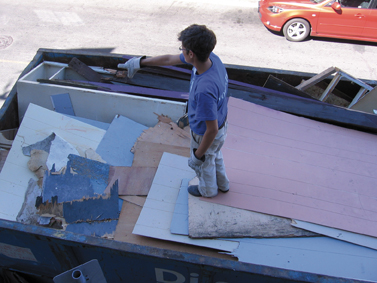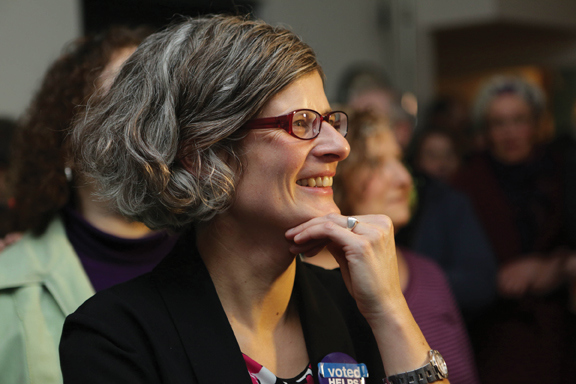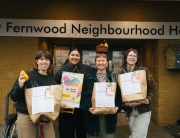On November 26, the Village Vibe caught up with Victoria’s new Mayor, Lisa Helps, to hear her views on neighbourhoods, villages and the significance of being from Fernwood
›› Lee Herrin
VV: What do you love most about living in Fernwood?
LH: The feeling of connectedness. I go to get my groceries at Aubergine and I know Leon and I have a long conversation—I know the people who own the pub, who run the coffee shop…it’s where I get my hair cut. I guess what I love most is the real village feel.
VV: You served on Fernwood NRG’s Board of Directors from just before we purchased the Cornerstone Building up to when we opened Park Place on Yukon Street. What role did your time on the Board play in terms of your determination to run for Council and then Mayor?
LH: Being Mayor is like being on the Board of Directors, but on a larger scale. It’s the same principles: it’s bringing people together, forming a common vision and taking action. One of the things that was solidified for me in the neighbourhood was the importance of our village centre, in particular, what can happen if a small group of people come together to work on revitalization. Now, as the Mayor, I’ve got a large group of people and many village centres to be responsible for. So it laid the groundwork for my understanding of the importance of connectedness and community and taking collective action. Everyone talks about building community, but we actually built community in Fernwood.
VV: What do you think the people of Victoria will be most surprised to learn about you through your time as Mayor?
LH: That I’m more than a chicken farmer. Part of the reason for the tight vote is that people have a hard time categorizing me—the mayor can be an urban farmer and a CEO at the same time. That’s something people aren’t used to, so I think that’s something that will surprise people: the ability that I have to lead the city.

Victoria’s new Mayor, Lisa Helps, is no stranger to hard work. She is seen here giving direction to volunteers during the renovation of the Cornerstone Building in 2005. Photo: Fernwood NRG
VV: Four years from now, how will Victoria be different?
LH: I think there will be a feeling that we are all “us”—City Hall will be everybody’s City Hall, there won’t be an “inside” and an “outside,” an “us” and a “them.” We will see fewer vacancies downtown, more local businesses, and village centres where there is economic activity and redevelopment. I would also like to see the City become a real leader in urban sustainability and urban planning.
VV: Some people call Victoria “the city of gardens.” I prefer to think of Victoria as “the city of villages.” In your vision for the City of Victoria, how important are neighbourhoods and villages?
LH: Critically, critically important. We are a city of villages. And, villages are challenging. The Official Community Plan was organized around the concept of strong village centres, but strong village centres have greater density and more commercial activity, and there can be opposition to that. That will be the biggest challenge in implementing the Official Community Plan—it sounds nice to say “I want a village,” but what does that mean in the 21st century? It means more density, it means thinking about creative ways that redevelopment can happen with less parking. I think villages are critical not just to the economies of neighbourhoods, but to the sense of connectedness and belonging—everyone wants to belong.
VV: What policy changes do you think are needed in order that Victoria’s villages will thrive into the future?
LH: I don’t think it is so much policy changes that are needed as it is an attitude change. We need to empower neighbourhood organizations and others to be more proactive, to give them the resources they need to do transportation planning, or redevelopment…we need to better resource the organizations that are leading in the villages. When a neighbourhood organization comes to City Hall and says “we want to plant a neighbourhood orchard,” or “we want to plant a community garden,” or, “we want to redevelop our building,” or, “we want to start a new child care program,” we say “Awesome! How can we help you do that?” It’s really more of an attitude change than a policy change.
VV: What investments are needed to ensure a bright future for our villages?
LH: Today, we do a poor job of this. I’d like to know from neighbourhoods what types of investments they need—this is where we move toward more participatory democracy and participatory budgeting. If we can build a better relationship with the neighbourhoods, we will have a strong foundation when we move into participatory budgeting to say “What do you need in your neighbourhood? Sidewalks? Crosswalks? Playgrounds?” I think that is the exciting opportunity to establish a participatory budgeting process where each neighbourhood says “This is how we would like money spent in our neighbourhood over the next several years.”
VV: What role can the City play to strengthen neighbourhoods and neighbourhood serving organizations?
LH: We need to see neighbourhoods and neighbourhood serving organizations as partners: partners in helping us build strong villages; partners in helping us build a prosperous city. We need to treat you as partners and we need to organize our resources at City Hall so that they are not just easy for neighbourhood serving organizations to access, but so there is a program to help you achieve your aims.
VV: On election night, you said to me: “The Mayor is from Fernwood.” What is the significance of that statement to you?
LH: I think that Fernwood is seen as “grassroots” or “alternative.” You say “Fernwood” and people get a particular image in their mind. You say “Fairfield” and they get a different image, or “James Bay” and they get a different image still. This is the strength of our city—each village has its own character. It says a lot to me about the direction the city is going. It says a lot about a new energy that is bubbling up around creativity and innovation. It’s a symbol of change—the mayor is a lot of things the mayor hasn’t been before. It’s a sense of new possibility that the Mayor is from Fernwood.






